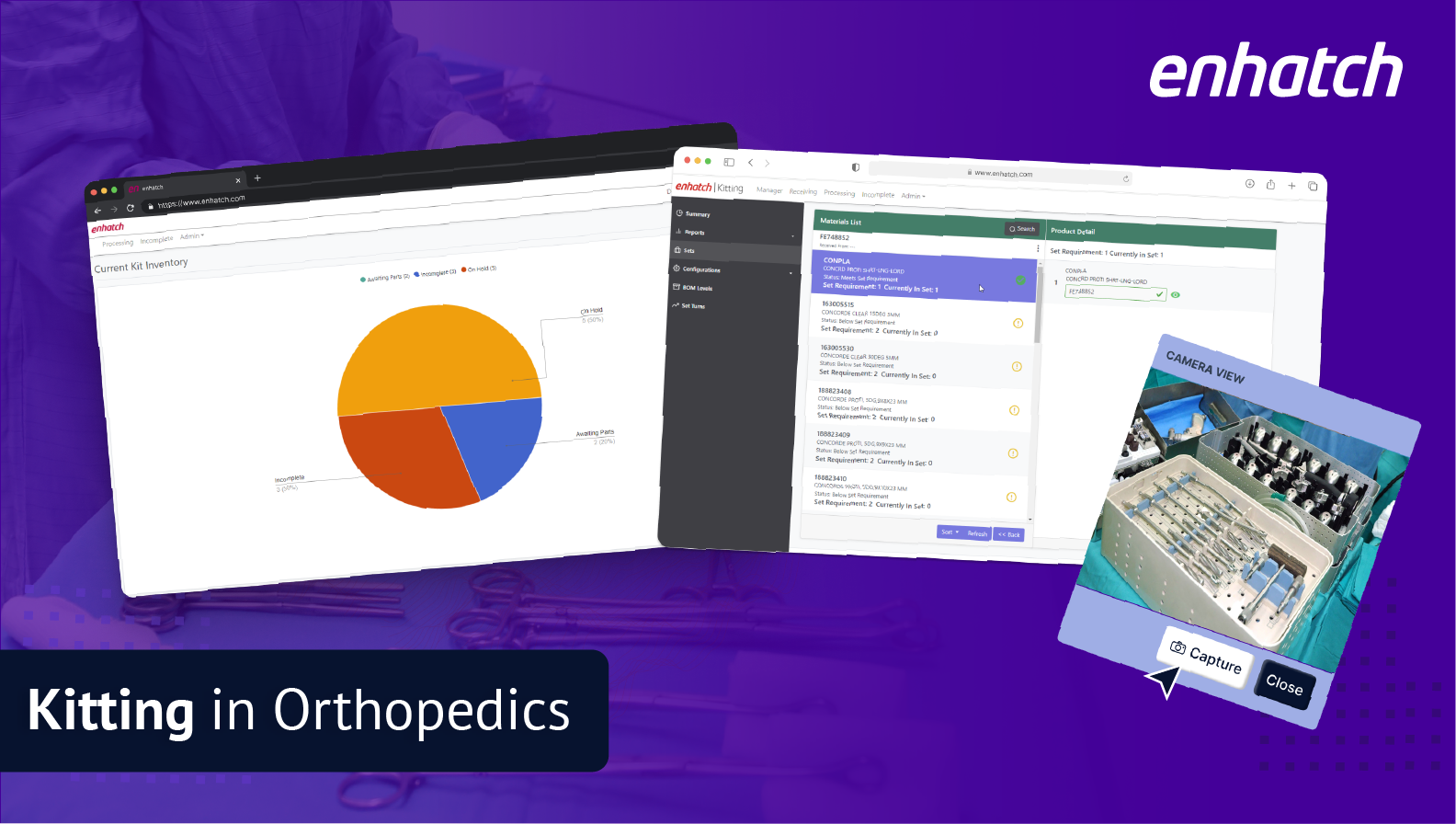Medical Device Kitting: Optimize Inventory and Maximize Service Levels

Kitting is an operational function that is crucial to orthopedic device manufacturers. It involves assembling and packaging various components, instruments, and implants needed for specific medical procedures into a single kit.
These implant and instrument kits are then supplied to healthcare facilities to cover surgeries.
Implant and instrument kits are also often part of loaner operations in orthopedic companies. In large medical device companies, loaners are crucial for ensuring surgery coverage.
Suppose a particular product kit/set is unavailable at the branch/distributor location, loaner operations will provide an implant or instrument kit to the sales branch/distributor to cover the required surgery. After usage, the implant and instrument kits are returned to loaners to inspect, replenish, and sterilize.
Orthopedic supply chains: Reducing inventory costs and increasing operational efficiency
Kitting, while essential, has its challenges. Driving efficiencies in kitting operations presents unique and complex hurdles for orthopedic companies. From managing intricate inventory to meeting stringent quality and regulatory requirements, orthopedic manufacturers are constantly navigating many challenges.
Also, due to the required high service levels, and manual processes especially in loaner operations, orthopedic companies have traditionally carried more inventory to ensure fulfillment.
However, the status quo will not work, as supply chain efficiency has recently become a key focus in medical device manufacturing. Factors contributing to this include an increasing shift to a value-based healthcare system in the United States and pricing pressure on medical device companies.
So, how can orthopedic manufacturers optimize their kitting process to drive tangible efficiency improvements and improve customer service levels?
Adopting advanced supply chain solutions (kitting and inventory management software) to improve and streamline operations is the answer.
Kitting operations: Inventory management and process complexities
Orthopedic, spine, and trauma companies face several challenges in their kitting operations.
Intricate nature of orthopedic products
The intricate nature of orthopedic products requires excellent attention to detail. Orthopedic, trauma, and spine implant and instrument kits contain several items. Putting a kit together requires great attention to detail and is time-consuming.
Implementing an effective inventory management system with visibility into each step of operations is crucial to ensure that all required products or components are available for kit assembly in warehouse operations.
Manual processes in orthopedic kitting operations
Many medical device companies have manual processes that often lead to inefficiencies. The result is prolonged lead times, increased costs, and a heightened risk of errors. For example, we have seen cases where a spine kit's assembly and inspection process can take over two hours if most processes are manual.
100% traceability: Tracking required at the kit and individual item level
Medical device companies need to track the kit and the individual items within each implant and instrument kit, which adds to the complexity.
High service levels for surgery coverage
High service levels are a requirement, as loaner kits are often used to cover immediate surgery.
Tech-driven warehouse kitting: Transforming operations with technology
Here are some ways in which the adoption of kitting software with advanced functionality can dramatically improve your kitting process.
Reduce kitting time by automation
By adopting an advanced kitting solution, medical device companies can significantly reduce kitting times.
For example, after implementing Enhatch's inventory management software, one of our customers reduced their kitting times by up to 80%.
Reduction in lead times is possible mainly due to the ability to automate multiple steps of the process and eliminate redundancies. For example, generating the inspection report is a crucial but time-consuming part of the kitting process.
Many medical device companies generate the inspection process manually. The right supply chain solution can help automate inspection report generation and significantly reduce the time taken for this process.
End-to-end visibility into each stage of the kitting process is also crucial for reducing lead times and alleviating bottlenecks. An advanced supply chain solution can provide medical device companies with this visibility.
For example, a supply chain solution can link a sales order to each tray for inspection. As traceability is a vital requirement, such a solution can also provide visibility at both the tray and individual item levels.
Improve kit utilization and service levels
With cutting-edge supply chain solutions, medical device companies can reduce the turnaround time (TAT) for kits, covering more surgeries with the same number of kits. This can help improve kit utilization and reduce inventory.
Also, dashboards can provide visibility into kit usage and utilization by product line. High kit utilization indicates high surgery demand. By viewing these dashboards, operations managers can build more kits in areas of high utilization to meet service-level requirements.
Rapidly expand kitting capacity
By automating and digitizing processes, medical device companies can significantly reduce their kitting times. This allows them to do more with their existing headcount and rapidly expand operational capacity.
At Enhatch, we have seen customers increase existing operational capacity by up to 5X with existing headcount after implementing our kitting solution.
With an advanced supply chain solution, medical device companies can significantly reduce new employee onboarding times. This can help with quick employee ramp-up for additional capacity expansion if necessary to satisfy their growing business needs.
Significantly lower hiring costs
Medical device companies can significantly lower hiring costs with a highly digitized supply chain solution. With a highly manual kitting process, companies must hire more expensive employees with higher skill sets to run it.
However, with a highly digitized and automated supply chain solution, medical device companies can hire less skilled employees to run the same process. This will reduce their hiring costs and overall labor costs.
Key takeaways
- Medical device kitting for orthopedics, spine, and trauma is highly complex.
- Kitting complexity due to the intricate nature of the products, the need for precise assembly, and stringent regulatory requirements.
- Medical device companies can find it challenging to improve kitting efficiency and reduce costs.
- Implementing advanced kitting and inventory management software is crucial for streamlining kitting operations, significantly reducing kitting times, and eliminating redundancies.



